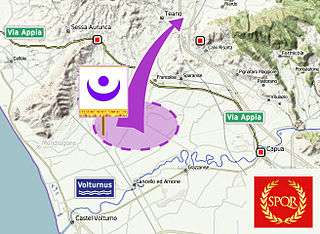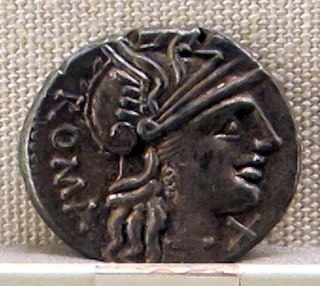
Quintus Fabius Maximus Verrucosus, surnamed Cunctator, was a Roman statesman and general of the third century BC. He was consul five times and was appointed dictator in 221 and 217 BC. He was censor in 230 BC. His agnomen, Cunctator, usually translated as "the delayer", refers to the strategy that he employed against Hannibal's forces during the Second Punic War. Facing an outstanding commander with superior numbers, he pursued a then-novel strategy of targeting the enemy's supply lines, and accepting only smaller engagements on favourable ground, rather than risking his entire army on direct confrontation with Hannibal himself. As a result, he is regarded as the originator of many tactics used in guerrilla warfare.
This article concerns the period 219 BC – 210 BC.

Year 217 BC was a year of the pre-Julian Roman calendar. At the time it was known as the Year of the Consulship of Geminus and Flaminius/Regulus. The denomination 217 BC for this year has been used since the early medieval period, when the Anno Domini calendar era became the prevalent method in Europe for naming years.

Marcus Claudius Marcellus, five times elected as consul of the Roman Republic, was an important Roman military leader during the Gallic War of 225 BC and the Second Punic War. Marcellus gained the most prestigious award a Roman general could earn, the spolia opima, for killing the Gallic military leader and king Viridomarus in single combat in 222 BC at the Battle of Clastidium. Furthermore, he is noted for having conquered the fortified city of Syracuse in a protracted siege during which Archimedes, the famous mathematician, scientist, and inventor, was killed, despite Marcellus ordering the soldiers under his command not to harm him. Marcus Claudius Marcellus died in battle in 208 BC, leaving behind a legacy of military conquests and a reinvigorated Roman legend of the spolia opima.

The gens Fabia was one of the most ancient patrician families at ancient Rome. The gens played a prominent part in history soon after the establishment of the Republic, and three brothers were invested with seven successive consulships, from 485 to 479 BC, thereby cementing the high repute of the family. Overall, the Fabii received 45 consulships during the Republic. The house derived its greatest lustre from the patriotic courage and tragic fate of the 306 Fabii in the Battle of the Cremera, 477 BC. But the Fabii were not distinguished as warriors alone; several members of the gens were also important in the history of Roman literature and the arts.
Quintus Baebius Tamphilus was a praetor of the Roman Republic who participated in negotiations with Hannibal attempting to forestall the Second Punic War.
The gens Fulvia, originally Foulvia, was one of the most illustrious plebeian families at ancient Rome. Members of this gens first came to prominence during the middle Republic; the first to attain the consulship was Lucius Fulvius Curvus in 322 BC. From that time, the Fulvii were active in the politics of the Roman state, and gained a reputation for excellent military leaders.
Marcus Cornelius Cethegus was a Roman Republican consul and censor during the Second Punic War, best known as a political ally of his kinsman Scipio Africanus.

The Battle of Ager Falernus was a skirmish during the Second Punic War between the armies of Rome and Carthage. After winning the Battle of Lake Trasimene in Italy in 217 BC, the army commanded by Hannibal marched south and reached Campania. The Carthaginians ultimately moved into the district of Falernum, a fertile river valley surrounded by mountains.

The Battle of Beneventum was fought in 214 BC near modern Benevento during the Second Punic War. Roman legions under Tiberius Sempronius Gracchus defeated Hanno's Carthaginian forces, denying Hannibal reinforcements. Livy gives a brief description of the battle, which was part of the Roman campaign to subdue the southern Italian city-states that had joined Hannibal after the Battle of Cannae.
Publius Sempronius C.f. Tuditanus was a Roman Republican consul and censor, best known for leading about 600 men to safety at Cannae in August, 216 BC and for the Treaty of Phoenice which ended the First Macedonian War, in 205 BC.
Tiberius Sempronius Gracchus was a Roman republican consul in the Second Punic War. He was son of the Tiberius Sempronius Gracchus who was consul in 238 BC, who was apparently the first man from his branch of the family to become a consul.
Manius Pomponius Matho was a Roman general who was elected consul for the year 233 BC with Quintus Fabius Maximus Verrucosus. He was also the maternal grandfather of the general and statesman Scipio Africanus.

Quintus Caecilius Metellus was a pontiff in 216 BC, aedile of the plebeians in 209 BC, curule aedile in 208 BC, magister equitum in 207 BC, consul in 206 BC, dictator in 205 BC, proconsul of Bruttium in 204 BC, and an ambassador at the court of Philip V of Macedon in 185 BC.

The Battle of Canusium also known as the Battle of Asculum was a three-day engagement between the forces of Rome and Carthage. It took place in Apulia during the spring of 209 BC, the tenth year of the Second Punic War. A larger Roman offensive, of which it was a part, aimed to subjugate and to punish cities and tribes that had abandoned the alliance with Rome after the Battle of Cannae, and to narrow the base of the Carthaginian leader, Hannibal, in southern Italy.

The gens Minucia was an ancient Roman family, which flourished from the earliest days of the Republic until imperial times. The gens was apparently of patrician origin, but was better known by its plebeian branches. The first of the Minucii to hold the consulship was Marcus Minucius Augurinus, elected consul in 497 BC.

Quintus Fabius Maximus was a consul of the Roman Republic in 213 BC. He was the son of Quintus Fabius Maximus Verrucosus, the famous dictator who invented Fabian strategy, and served with his father during the Second Punic War.

Hannibal's March on Rome occurred in 211 BC during the Second Punic War; the Carthaginian leader Hannibal marched by surprise with his army towards Rome, initially causing great concern among the leaders and citizens of the republic. The raid, however, ended in failure; soon, faced with firm resistance from the Romans, Hannibal left the city to head with his troops to Campania.










